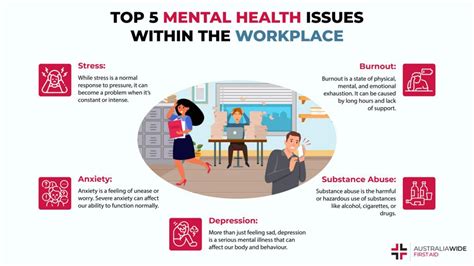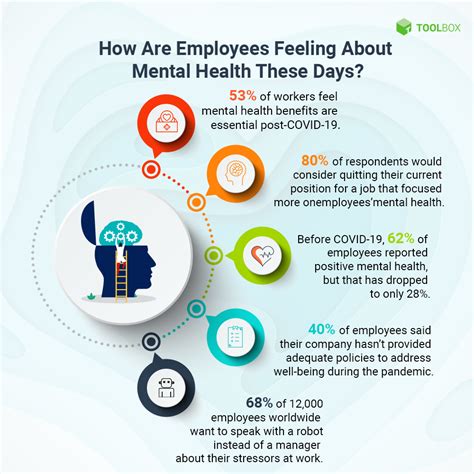Intro
Boost workplace well-being by breaking the stigma around mental health. Discover how to create a supportive environment, reduce stress, and promote employee mental wellness. Learn strategies for open conversations, accommodations, and resources to foster a culture of inclusivity and understanding, ultimately improving job satisfaction and productivity.
The modern workplace can be a breeding ground for stress, anxiety, and other mental health issues. With the increasing demands of work, long hours, and the pressure to perform, it's no wonder that many employees struggle to maintain good mental health. However, mental health issues are often stigmatized, and employees may feel uncomfortable discussing their struggles or seeking help. This needs to change.
Mental health is just as important as physical health, and it's essential that we break the stigma surrounding mental health issues in the workplace. By creating a supportive and inclusive work environment, employers can help employees feel more comfortable opening up about their struggles and seeking the help they need. In this article, we'll explore the importance of mental health in the workplace, the benefits of breaking the stigma, and provide tips for employers and employees on how to create a more supportive work environment.

The Importance of Mental Health in the Workplace
Mental health issues can affect anyone, regardless of their job title, industry, or background. According to the World Health Organization (WHO), depression and anxiety disorders cost the global economy $1 trillion in lost productivity each year. In the United States alone, it's estimated that mental health issues cost employers $225 billion annually.
The consequences of poor mental health can be severe, including decreased productivity, absenteeism, presenteeism (being physically present but not fully productive), and turnover. Moreover, mental health issues can also lead to physical health problems, such as cardiovascular disease, diabetes, and obesity.
The Benefits of Breaking the Stigma
Breaking the stigma surrounding mental health issues in the workplace can have numerous benefits for both employees and employers. By creating a supportive work environment, employers can:
- Improve employee well-being and productivity
- Increase employee engagement and retention
- Reduce absenteeism and presenteeism
- Enhance creativity and innovation
- Improve company culture and reputation
For employees, breaking the stigma can mean:
- Feeling more comfortable opening up about their struggles
- Accessing support and resources to manage their mental health
- Reducing feelings of shame and guilt
- Improving their overall well-being and quality of life

Creating a Supportive Work Environment
So, how can employers create a supportive work environment that encourages employees to prioritize their mental health? Here are some tips:
- Develop a mental health policy: Create a comprehensive policy that outlines the company's approach to mental health, including support services, leave policies, and employee resources.
- Provide training and education: Offer regular training and education programs to help employees understand mental health issues, reduce stigma, and promote a supportive work culture.
- Encourage open conversations: Create a safe and non-judgmental space for employees to discuss their mental health struggles and concerns.
- Offer employee assistance programs (EAPs): Provide access to confidential counseling services, mental health resources, and support groups.
- Foster a positive work culture: Promote a positive work culture that values employee well-being, recognizes achievements, and encourages work-life balance.
Employee Strategies for Prioritizing Mental Health
While employers play a critical role in creating a supportive work environment, employees also have a responsibility to prioritize their mental health. Here are some strategies for employees:
- Take breaks and practice self-care: Take regular breaks throughout the day to stretch, move, and relax.
- Set boundaries: Establish clear boundaries between work and personal life to maintain a healthy work-life balance.
- Seek support: Reach out to colleagues, managers, or EAPs for support and guidance.
- Prioritize sleep and exercise: Make time for regular exercise and aim for 7-8 hours of sleep each night.
- Stay connected: Build and maintain social connections with colleagues, friends, and family.

Breaking Down Barriers to Mental Health Support
Despite the importance of mental health, many employees face barriers to seeking support. Here are some common barriers and potential solutions:
- Stigma and shame: Encourage open conversations and education programs to reduce stigma and promote a supportive work culture.
- Fear of judgment: Create a safe and non-judgmental space for employees to discuss their mental health struggles and concerns.
- Lack of resources: Provide access to EAPs, counseling services, and mental health resources.
- Cost and accessibility: Offer flexible work arrangements, telecommuting options, and access to affordable mental health services.
Conclusion
Breaking the stigma surrounding mental health issues in the workplace is crucial for creating a supportive and inclusive work environment. By prioritizing mental health, employers can improve employee well-being, productivity, and retention, while also enhancing company culture and reputation. Employees also have a responsibility to prioritize their mental health and seek support when needed. Together, we can break down barriers to mental health support and create a healthier, more supportive work environment.
What is the impact of mental health on employee productivity?
+Mental health issues can significantly impact employee productivity, leading to decreased performance, absenteeism, and presenteeism.
How can employers create a supportive work environment for mental health?
+Employers can create a supportive work environment by developing a mental health policy, providing training and education, encouraging open conversations, and offering employee assistance programs (EAPs).
What are some common barriers to mental health support in the workplace?
+Common barriers to mental health support include stigma and shame, fear of judgment, lack of resources, and cost and accessibility.
